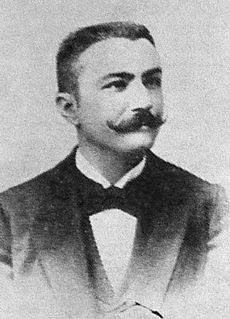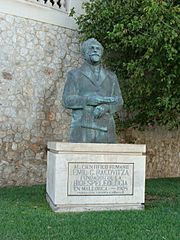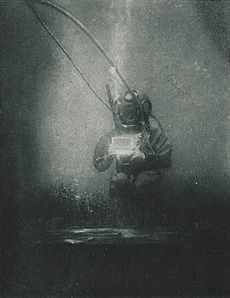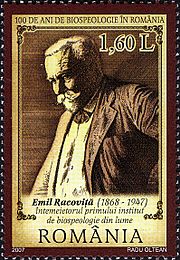Emil Racoviță facts for kids
Quick facts for kids
Emil Racoviță
|
|
|---|---|

Racoviță around 1897
|
|
| Born |
Emil Gheorghe Racoviță
15 November 1868 Iași, United Principalities of Moldavia and Wallachia
|
| Died | 17 November 1947 (aged 79) |
| Resting place | Hajongard Cemetery, Cluj-Napoca |
| Nationality | Romanian |
| Alma mater | University of Paris |
| Known for |
|
| Scientific career | |
| Fields | Biology, speleology, zoology |
| Institutions | Babeș-Bolyai University |
| Thesis | Le lobe cephalique et l’encéphale des Annélides Polychète (1896) |
| Doctoral advisor | Henri de Lacaze-Duthiers |
Emil Gheorghe Racoviță (born November 15, 1868 – died November 17, 1947) was a famous Romanian scientist. He was a biologist, zoologist, and explorer of caves (a speleologist). He also explored Antarctica!
Emil Racoviță, along with Grigore Antipa, helped make natural sciences popular in Romania. He was the first Romanian to go on a science trip to Antarctica. He was also a respected professor and researcher. He even led the Romanian Academy from 1926 to 1929.
Contents
Growing Up and Education
Emil Racoviță was born in Iași, Romania. He grew up on his family's land in Șurănești. He started school in Iași, where one of his teachers was the famous writer Ion Creangă. He finished high school in 1886.
After high school, he went to the University of Paris to study law. He earned a law degree in 1889. But he soon realized his true passion was for science, not law.
His main teacher in science was Henri de Lacaze-Duthiers. He was a zoologist and biologist at the Sorbonne. Emil Racoviță earned his science degree in 1891. He then got his Ph.D. in 1896. His Ph.D. paper was about the brains of certain worms called polychaetous annelids.
The Belgica Antarctic Expedition
Emil Racoviță was a promising young scientist. Because of this, he was chosen to join an international team. This team went on a science trip to Antarctica. They sailed on a ship called the Belgica. The trip was led by a Belgian officer named Adrien de Gerlache.
The Ship and Its Crew
On August 16, 1897, the Belgica left the port of Antwerp. It was an old Norwegian wooden whaler ship. It was heading south towards Antarctica. The ship had three masts and a 160-horsepower engine.
The team had 19 members from many different countries. The first mate of the ship was Roald Amundsen. He later became famous for reaching the South Pole in 1911. Besides Racoviță, the team included Belgian physicist Émile Danco. There was also Polish geologist Henryk Arctowski and American doctor Frederick Cook.
Important Science Work
The team left the ship's deck 22 times. They did this to collect scientific information and perform experiments. Racoviță was the first scientist to gather plant and animal samples from beyond the Antarctic Circle.
The Belgica team also made the first daily weather recordings in Antarctica. They took measurements every hour for a whole year. The scientists also gathered facts about ocean currents and the Earth's magnetism. After the trip, 10 books of scientific findings were published. The expedition was seen as a big success.
Challenges Faced
The expedition faced many difficulties. From March 10, 1898, to March 14, 1899, the Belgica was stuck in thick ice. It could not move forward. The crew had to dig a 75-meter (246-foot) long canal through 6-meter (20-foot) thick ice. This was to create a path to open water.
The Belgica returned to Europe in 1899. Sadly, two team members died during the trip. Carl Wiencke, a Norwegian sailor, was lost overboard. Émile Danco died from natural causes.
Racoviță wrote a diary about the trip, published in 1899. It describes the hard times the team went through. Photos from that time show how much he had changed after returning from the expedition. His research results were published in 1900. The book was called The life of animals and plants in Antarctica. A year later, Racoviță became the director of a research center in Banyuls-sur-Mer, France.
Later Life and Discoveries

Emil Racoviță continued his research. He became very important in speleology, the study of caves. He explored over 1,400 caves in France, Spain, Algeria, Italy, and Slovenia. He is known as one of the founders of biospeleology. This is the study of life in caves. He was especially interested in isopods, a type of small creature, and found many new ones.
In 1919, Racoviță became the head of the biology department at the Babeș-Bolyai University in Cluj-Napoca, Romania. He was also the Rector (leader) of the university from 1929 to 1930. On April 26, 1920, he started the world's first speleological institute there. It became an independent institute in 1956.
In 1920, he became a full member of the Romanian Academy. He served as its President from 1926 to 1929.
After World War II, Racoviță worked hard to rebuild the institute. He passed away in November 1947 in Cluj-Napoca. He was buried in the city's Hajongard Cemetery.
Racoviță's Legacy
Two caves are named after Emil Racoviță. One is the Emil Racoviță Cave in Criva, Briceni, Moldova. It is the largest cave in Moldova. The other is the Racoviță Cave in Iabalcea, Romania.
In 2006, the first Romanian Antarctic research station was named the Law-Racoviță Station.
Poșta Română, the Romanian postal service, has issued several stamps in his honor. These stamps celebrate his life and achievements. For example, a stamp in 2007 marked 100 years since he founded the first biospeleology institute.
In 2018, to celebrate 150 years since his birth, the National Bank of Romania released a special silver coin with his image.
See also
 In Spanish: Emil Racoviță para niños
In Spanish: Emil Racoviță para niños




